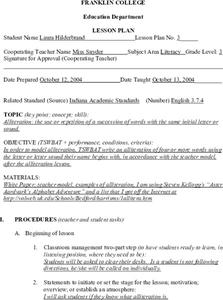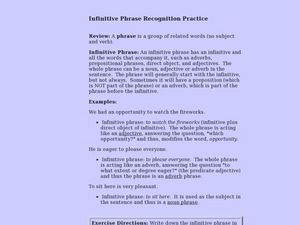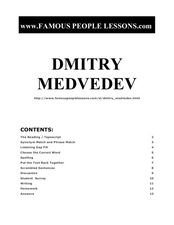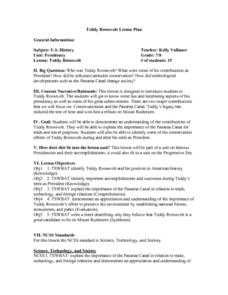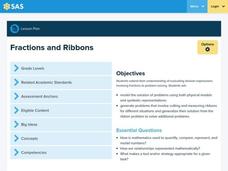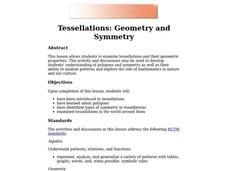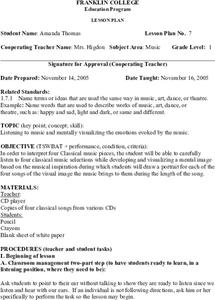Curated OER
Character Ambassadors
Students act as ambassadors. In this character education lesson, students take on the roles of ambassadors of the character traits listed. Students write essays regarding the character traits they select.
Curated OER
Solving Quadratic Equations by Graphing
Pupils solve quadratic equation by graphing. In this algebra lesson, students use the TI calculator to get a visual of their graph. They create a table of values, plot their points and graph the parabola.
Curated OER
Alliteration
Third graders explore the use of alliteration. They discuss alliteration and examine various examples of alliteration in various stories. Students discuss the examples of alliteration and create their own examples of alliteration using...
Curated OER
Infinitive Phrase Recognition Practice
In this infinitive phrase practice worksheet, middle schoolers read an informative activity. Students then respond to 10 questions that require them to identify the infinitive phrases in the sentences and label them as noun, adjective,...
Curated OER
Dmitry Medvedev
In this famous person worksheet, students read a passage about Dmitry Medvedev and then complete a variety of in-class and homework activities to support comprehension, including partner interviews, spelling, cloze, synonym...
Curated OER
GRAVE OF THE FIREFLIES
Students engage in a video activity to research the effects of war upon the Japanese to live in the world after World War II. They answer specific questions in order to complete the unit.
Curated OER
Introduction to Fractals: Infinity, Self-Similarity and Recursion
Students think about several of the concepts from fractals, including recursion and self similarity. They use mathematical concepts of line segments, perimeter, area and infinity are used, and skill at pattern recognition is practiced.
Curated OER
Ways to Prevent the Spread of Pathogens
Fifth graders discuss the ways to prevent the spread of pathogens. In groups, they use the internet to research the ways to prevent disease from spreading. They use this information to create a poster and share the information with the...
Curated OER
Warming the Earth
First graders investigate how the sun warms the Earth and examine the rotation of the Earth and the sun. They create an illustration of the sun, examine a solar system model, and listen to the book "The Sun: Our Nearest Star." They also...
Curated OER
Giving Directions
First graders view the object on their desk observing the colors, patterns, and the way the object is put together but not touching it. They then write on paper the directions they would give someone so that they would be able to build...
Curated OER
Plant Pollination and Fertilization
Fourth graders research and apply knowledge about plant pollination and fertilization in this lesson. They color on a flower diagram the anther, the pistil, the pollen, the pollen tube, the ovary, and the egg to show the process of...
Curated OER
The Hundred Penny Box
Students analyze the advantages of regular saving and how savings grow with compounding. After reading the story "The Hundred Penny Box", students define the terms "interest," "interest rate," and "compounding." Through several...
Curated OER
Teddy Roosevelt
Students examine the life, contributions, and influence of Teddy Roosevelt. They view a slideshow lecture and take notes on a handout, filling in the blanks on the handout. Students then write a persuasive letter to a governmental...
Curated OER
Adding "Homeside" to "Schoolside" Learning
Students participate in activities in order to improve their ability to work cooperatively in groups at school as well as with their family at home. They complete the activities at home with their family then discuss the results of the...
Curated OER
Emotion or Reason?
Students use persuasive devices to construct oral or written arguments. In this arguments lesson, students discuss the types of persuasive devices used in arguments and form groups to select a topic to research. Students create a...
Curated OER
Vocabulary Exercise
In this vocabulary worksheet, students fill in the blanks, group items into categories, match objects to definitions, and more. Students complete 5 activities total.
Curated OER
Where the Rubber Meets the Road
Eighth graders examine two different types of tires and the effects of different factors on the amount of force needed to overcome sliding friction such as when the vehicle tries to stop.
Curated OER
Height of Bounce
Eighth graders determine the relationship between the height of bounce of a ping-pong ball and the height from which it was dropped. They are assessed on the ability to record and interpret data, graph data, make predictions, and make...
Curated OER
Solar System: Let's Take a Trip
Third graders consider outer space. In this introductory solar system lesson, 3rd graders complete a KWL chart and listen to the story The Magic School Bus: Lost in the Solar System, by Joanna Cole & Bruce Degen. They will contribute...
Pennsylvania Department of Education
Fractions and Ribbons
Fifth graders solve division problems using partial quotients. In this long division lesson, 5th graders practice seeing division as a process of repeated subtraction and estimation. This lesson provides a script for the teacher.
Curated OER
JANE AND THE DRAGON
Third graders act out a play called Jane and the Dragon. Students develop vocabulary through dialogue. They delve into the feelings of others through learning about the characters. They also identify the characteristics of various types...
Curated OER
Tessellations: Geometry and Symmetry
Students examine tesselllations and their geometric properties. They have a better knowledge of polygons, can identify types of symmetry in tessellations. Also students use visulization, spatial reasoning, and geometric modeling to...
Curated OER
Music and Emotions
First graders examine how certain types of music can evoke emotions and mental images. They fold a piece of paper into four equal sections, and create a picture of what they are visualizing in each section while listening to four...
Curated OER
Beginning, Middle, and End
First graders identify the beginning, middle, and ending of a story and describe the plot, setting, and the characters. As a class they read a picture story and identify the beginning, middle, and end. Students then draw a picture of...


